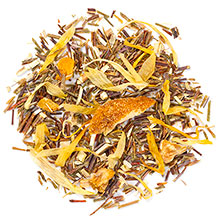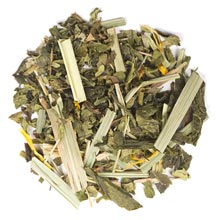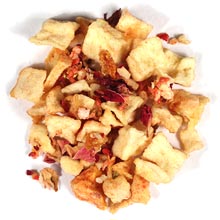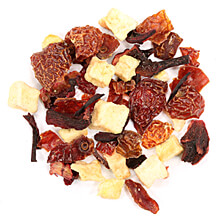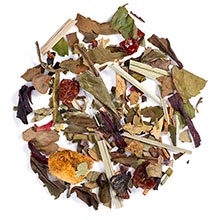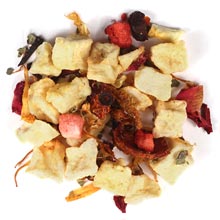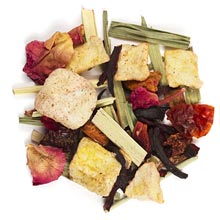by Abby Morrison
March 30, 2021
Welcome back to our great exploration of garden flavors.
Last time, we covered apple, coconut, watermelon, and pineapple. This time, we're back at it with even more fruit flavors to put a new spin on your favorite cup.
Citrus
A classic friend to tea, citrus fruits run the gamut from tart to sour to sweet and tangy, with common examples including lemon, lime, orange, grapefruit, and tangerine. Bergamot, which can't be eaten as a fruit, but has excellent oils, is the defining factor in any blend labeled Earl Grey. Citrus fruits have fragrant skins that can be used for zests, rinds that can be candied or used for fragrances, and segmented pulpy flesh for eating. They grow on trees and come in a wide variety of shapes, sizes, and colors, though most are round or oblong with colors like yellow, green, or orange.
Adagio offers a wide variety of citrus teas, including
Earl Grey Moonlight,
Earl Grey Bravo,
Earl Grey Lavender,
Citrus Mint Green,
Citron Green,
Green Rooibos Citron,
Grapefruit Oolong,
Grapefruit,
White Grapefruit, Lavender Lemon,
Lemon Soleil,
Pu-Erh Chorange,
Summer Night,
Orange,
Rooibos Orange,
Blood Orange,
Citrus Mate,
White Tangerine,
Tangerine Tuxedo, and
Chili Lime Green to name a few.
In custom blends, the pairings will depend on the type of citrus you are using. Tart flavors like lemon and lime typically go well with lighter teas, where they can add a punch of brightness or balance to sweeter flavors, whereas sweeter flavors like orange can pair better with more savory flavors like chocolate, dark teas, and spices.
Stone Fruits
Stone fruits grow on fruit trees and are characterized by the pit or stone found in their center. Examples include peach, apricot, mango, cherry, and plum. They are typically softer than other tree fruits like pears or apples, and are known for their rich, sweet flavors, though some varieties, like sour cherries, can be tart as well.
Examples of stone fruit teas include:
Peach,
White Peach,
Peach Oolong,
Peach Bellini,
Peach Serenity,
Matcha Peach,
Apricot Green,
Honeybush Apricot,
Mango,
Mango Green,
Mango Melange,
Mango Mate,
Blue Mango,
Cherry,
Cherry Green, and our
Dewy Cherry, a sour tisane.
In custom blends, stone fruits are hardy enough to stand up against darker teas and oolongs, though depending on the fruit, they can also pair well with lighter teas, other fruits (especially tropical flavors), citrus, spices, or sweets. What you do will depend most on the type of stone fruit you use.
Berries
Botanically speaking, there are a lot of unexpected berries out there, such as pumpkins, melons, and even cucumbers. On the other hand, many fruits that we would call berries, like strawberries and raspberries, are not real berries at all. This is because of the way that berries are scientifically categorized. That being said, for the purposes of this post, we'll be focusing on what are commonly understood as culinary, rather than scientific, berries, like strawberries, blackberries, raspberries, huckleberries, gooseberries, blueberries, cranberries, and elderberries. Berries are typically darker in color, with blues, purples, and reds being prominent, though some can come in lighter varieties, such as yellow or golden raspberries or white strawberries. Most berries grow on bushes, though some, like strawberries, grow on smaller plants. Berries can be sweet or tart and are often a combination of both.
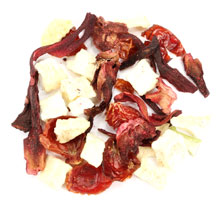
For Adagio teas, we've got nearly as many options as there are berries. Some good ones to start with include
Strawberry,
White Strawberry,
Wild Strawberry,
White Strawberry Basil,
Blackberry,
Blackberry Sage Oolong,
Raspberry,
Raspberry Green,
Raspberry Patch,
Blueberry,
White Blueberry,
Green Blueberry Rooibos,
Honeybush Blueberry Pancake, Matcha Blueberry,
Berry Blues,
Berry Blast,Cranberry, and our
Elderberry Wine tisane.
In custom blends, your choices will vary by the type of berry. Broadly speaking though, they can be a good way to brighten or sweeten a light white tea for spring or summer, add some rich sweetness to a darker tea, or blend well together to create a fruity cocktail. Typically, the darker the berry, the heartier it is when holding up to stronger flavors, with blackberries and blueberries holding up better to spices or darker teas while berries like strawberries and raspberries pair best with whites and greens.
Out of the Box Options
We've talked about several broader kinds of fruits and veggies, but some flavors are so distinct or different they don't quite fit into any one category. Passionfruit, dragon fruit (technically a kind of cactus), papaya, pomegranate, and chilis all fit this bill. Fear not, however. For those who really want to be bold, we've got you covered.
For teas that venture farther off the beaten path, we suggest:
Pomegranate,
Pomegranate Green,
Pomegranate Grove, Papaya Pouchong,
Dragon Fruit Dream,
Passionfruit, and
Passionfruit Tango.
In custom blends, these will vary wildly based on the fruit or vegetable. Try a few teas to find what you like, and then explore! The only limit is your willingness to try!
With that, we end our garden tour. With so many flavors to try, the possibilities are endless. Try finding a few ways to get friendly with your favorite fruits and veggies from our list, and if you discover a new must-have for your collection, let us know on social @adagioteas! Next up? Accent flavors.

